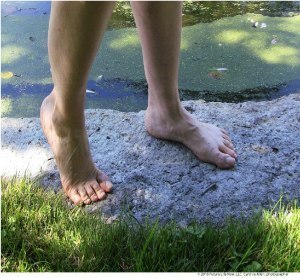Our feet take a lot of abuse, and for the most part they are intricately designed to handle it. Their multi-directional arches are akin to springs that load with tension. When released, they propel us forward or up. If the 26 bones of the foot cannot harmoniously articulate and vary their shape, we lose that springiness. Walking requires extra effort, thus contributing to poor alignment, to osteoarthritis caused by compression and sheer in joints, and to a host of other ailments.
 Balanced, fluid walking nourishes your bones and activates your circulatory system for whole-body vitality instead of dis-ease. As a Feldenkrais practitioner, I've had a lot of experience with a wide variety of feet. As a person, I've encountered my own foot challenges. I assure you, I feel for you if you are not best friends with your feet.
Balanced, fluid walking nourishes your bones and activates your circulatory system for whole-body vitality instead of dis-ease. As a Feldenkrais practitioner, I've had a lot of experience with a wide variety of feet. As a person, I've encountered my own foot challenges. I assure you, I feel for you if you are not best friends with your feet.
Here are five key tips for befriending your feet:
1. Choose shoes wisely. Shoes literally mold the structure of your feet, shifting your bones and changing their shape. Obviously, high heels or tight shoes worn day in and day out will lead to problems. But even less extreme styles can have a big impact. Your toes are meant to be wider than the ball of your foot, so when shoes force the narrowing of your toes, you can expect bunions, fused joints, hammer toes, and fallen arches. Look for shoes with a wide toe box and zero heel lift or drop.
2. Go barefoot. For most healthy individuals, balance problems are more likely to develop from being over supported by shoes than under supported. Balance is a dynamic process of continually adjusting to change; shoes interfere by dramatically reducing the amount of stimulation from the ground. And by the way, keep your children out of shoes as much as possible. Their bones are still forming, and the less constriction, the better.
3. Stimulate your foot with different surfaces. Walk on a variety of surfaces, such as different types of carpets, hardwood floors, grass, sand, and pebbles. This kind of stimulation is good for your feet, your balance, and your brain.
4. Watch how you stand. Try to distribute the weight from the ball of the foot toward the center of the heel. Avoid hyperextending the knees.
5. Improve your balance. While your feet affect your balance, it is also true that your balance affects your feet. Both are key to a healthy walk. A quick way to play with your balance is to walk an imaginary line coming as close to putting one foot in front of the other as you are able. When you feel good about that, walk an imaginary 2x4 board. You will be amazed at how use of the imagination ups the challenge. And then, when you have mastered that, you can close your eyes and walk and imaginary board.
A problem in the foot never stays in the foot, so start working with your feet at the earliest signs of discomfort. Problems like plantar fasciitis, bunions, hammer toes, Morton's Neuroma and the like don't pop up out of nowhere. They are a process. Keeping the spring in your step can go a long way towards maintaining your overall health.
Want more foot and balance enhancing ideas? Check out this video.
You can find Cynthia Allen working on movement options at Future Life Now or on youtube